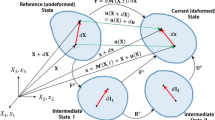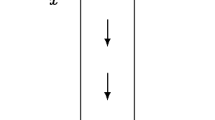Abstract
In this chapter, a coupled thermomechanical gradient-enhanced continuum plasticity theory containing the flow rules of the grain interior and grain boundary areas is developed within the thermodynamically consistent framework. Two-dimensional finite element implementation for the proposed gradient plasticity theory is carried out to examine the micro-mechanical and thermal characteristics of small-scale metallic volumes. The proposed model is conceptually based on the dislocation interaction mechanisms and thermal activation energy. The thermodynamic conjugate microstresses are decomposed into dissipative and energetic components; correspondingly, the dissipative and energetic length scales for both the grain interior and grain boundary are incorporated in the proposed model, and an additional length scale related to the geometrically necessary dislocation-induced strengthening is also included. Not only the partial heat dissipation caused by the fast transient time but also the distribution of temperature caused by the transition from the plastic work to the heat is included into the coupled thermomechanical model by deriving a generalized heat equation. The derived constitutive framework and two-dimensional finite element model are validated through the comparison with the experimental observations conducted on microscale thin films. The proposed enhanced model is examined by solving the simple shear problem and the square plate problem to explore the thermomechanical characteristics of small-scale metallic materials. Finally, some significant conclusions are presented.
Similar content being viewed by others
References
Abaqus, User’s Manual (Version 6.12) (Dassault Systemes Simulia Corporation, Providence, 2012)
E.C. Aifantis, J. Eng. Mater-T Asme. 106, 4 (1984)
E.C. Aifantis, Int. J. Plast. 3, 3 (1987)
K.E. Aifantis, J.R. Willis, J. Mech. Phys. Solids 53, 5 (2005)
A.H. Almasri, G.Z. Voyiadjis, Acta Mech. 209, 1–2 (2010)
L. Anand, M.E. Gurtin, S.P. Lele, C. Gething, J. Mech. Phys. Solids 53, 8 (2005)
A. Arsenlis, D.M. Parks, Acta Mater. 47, 5 (1999)
L. Bardella, J. Mech. Phys. Solids 54, 1 (2006)
D.J. Benson, H.H. Fu, M.A. Meyers, Mater. Sci. Eng. A 319, 319–321 (2001)
T. Bergeman, J. Qi, D. Wang, Y. Huang, H.K. Pechkis, E.E. Eyler, P.L. Gould, W.C. Stwalley, R.A. Cline, J.D. Miller, D.J. Heinzen, J. Phys. B-Atom. Mol. Opt. Phys. 39, 19 (2006)
S.D. Brorson, A. Kazeroonian, J.S. Moodera, D.W. Face, T.K. Cheng, E.P. Ippen, M.S. Dresselhaus, G. Dresselhaus, Phys. Rev. Lett. 64, 18 (1990)
H.B. Callen, Thermodynamics and an Introduction to Thermostatistics (Wiley, Hoboken, 1985)
P. Cermelli, M.E. Gurtin, Int. J. Solids Struct. 39, 26 (2002)
W.A.T. Clark, R.H. Wagoner, Z.Y. Shen, T.C. Lee, I.M. Robertson, H.K. Birnbaum, Scr. Met. Mater. 26, 2 (1992)
B.D. Coleman, W. Noll, Arch. Ration. Mech. Anal. 13, 3 (1963)
D. Faghihi, G.Z. Voyiadjis, J. Eng. Mater-T Asme. 136, 1 (2014)
N.A. Fleck, J.W. Hutchinson, Adv. Appl. Mech. 33, 295 (1997)
N.A. Fleck, J.W. Hutchinson, J. Mech. Phys. Solids 49, 10 (2001)
N.A. Fleck, G.M. Muller, M.F. Ashby, J.W. Hutchinson, Acta Metall. Mater. 42, 2 (1994)
N.A. Fleck, J.W. Hutchinson, J.R. Willis, P. Roy. Soc. A-Math. Phy. 470, 2170 (2014)
N.A. Fleck, J.W. Hutchinson, J.R. Willis, J. Appl. Mech-T Asme. 82, 7 (2015)
S. Forest, J. Eng. Mech-Asce. 135, 3 (2009)
S. Forest, M. Amestoy, Cr. Mecanique 336, 4 (2008)
P. Fredriksson, P. Gudmundson, Model. Simul. Mater. Sci. 15, 1 (2007)
A. Garroni, G. Leoni, M. Ponsiglione, J. Eur. Math. Soc. 12, 5 (2010)
S. Giacomazzi, F. Leroi, C. L'Henaff, J.J. Joffraud, Lett. Appl. Microbiol. 38, 2 (2004)
H. Gleiter, Acta Mater. 48, 1 (2000)
P. Gudmundson, J. Mech. Phys. Solids 52, 6 (2004)
M.E. Gurtin, Int. J. Plast. 19, 1 (2003)
M.E. Gurtin, J. Mech. Phys. Solids 52, 11 (2004)
M.E. Gurtin, J. Mech. Phys. Solids 56, 2 (2008)
M.E. Gurtin, L. Anand, J. Mech. Phys. Solids 53, 7 (2005)
M.E. Gurtin, L. Anand, J. Mech. Phys. Solids 57, 3 (2009)
M.E. Gurtin, E. Fried, L. Anand, The Mechanics and Thermodynamics of Continua (Cambridge University Press, Cambridge, 2010)
S. Han, T. Kim, H. Lee, H. Lee, Electronics System-Integration Technology Conference, 2008. ESTC 2008. 2nd (2008)
M.A. Haque, M.T.A. Saif, Acta Mater. 51, 11 (2003)
J.P. Hirth, J. Lothe, Theory of Dislocations (Krieger Publishing Company, 1982). ISBN: 0894646176, 9780894646171
Y. Huang, J. Qi, H.K. Pechkis, D. Wang, E.E. Eyler, P.L. Gould, W.C. Stwalley, J. Phys. B-Atom. Mol. Opt. Phys. 39, 19 (2006)
J.W. Hutchinson, Acta. Mech. Sinica-Prc. 28, 4 (2012)
J.S. Hwang, H.L. Park, T.W. Kim, H.J. Lee, Phys. Status Solidi a-Appl. Res. 148, 2 (1995)
A.M. Ivanitsky, D.A. Kadakov, Izv. Vyssh. Uchebn. Zaved Radiofiz. 26, 9 (1983)
T.W. Kim, H.L. Park, J. Cryst. Growth 159, 1–4 (1996)
T.W. Kim, H.L. Park, J.Y. Lee, Appl. Phys. Lett. 64, 19 (1994)
T.C. Lee, I.M. Robertson, H.K. Birnbaum, Scr. Metall. 23, 5 (1989)
S.P. Lele, L. Anand, Philos. Mag. 88, 30–32 (2008)
J.M. Lim, K. Cho, M. Cho, Appl. Phys. Lett. 110, 1 (2017)
W.J. Liu, K. Saanouni, S. Forest, P. Hu, J. Non-Equil. Thermody. 42, 4 (2017)
V.A. Lubarda, Int. J. Solids Struct. 45, 1 (2008)
D.L. McDowell, Int. J. Plast. 26, 9 (2010)
H. Mecking, U.F. Kocks, Acta Metall. 29, 1865–1875 (1981)
M.A. Meyers, A. Mishra, D.J. Benson, Prog. Mater. Sci. 51, 427 (2006)
H.B. Muhlhaus, E.C. Aifantis, Int. J. Solids Struct. 28, 7 (1991)
L. Nicola, Y. Xiang, J.J. Vlassak, E. Van der Giessen, A. Needleman, J. Mech. Phys. Solids 54, 10 (2006)
W.D. Nix, H.J. Gao, J. Mech. Phys. Solids 46, 3 (1998)
T. Ohmura, A.M. Minor, E.A. Stach, J.W. Morris, J. Mater. Res. 19, 12 (2004)
N. Ohno, D. Okumura, J. Mech. Phys. Solids 55, 9 (2007)
P.A. Parilla, M.F. Hundley, A. Zettl, Solid State Commun. 87, 6 (1993)
H.L. Park, S.H. Lee, T.W. Kim, Compd. Semicond. 1995, 145 (1996)
J.M. Pipard, N. Nicaise, S. Berbenni, O. Bouaziz, M. Berveiller, Comput. Mater. Sci. 45, 604–610 (2009)
X. Qing, G. Xingming, Int. J. Solids Struct. 43, 25–26 (2006)
W.A. Soer, K.E. Aifantis, J.T.M. De Hosson, Acta Mater. 53, 17 (2005)
Y. Song, G.Z. Voyiadjis, Int. J. Solids Struct. 134, 195–215 (2018a)
Y. Song, G.Z. Voyiadjis, J. Theor. App. Mech-Pol. 56, 2 (2018b)
S. Sun, B.L. Adams, W.E. King, Philos. Mag. A 80, 1 (2000)
D.Y. Tzou, Y.S. Zhang, Int. J. Eng. Sci. 33, 10 (1995)
R. Venkatraman, P.R. Besser, J.C. Bravman, S. Brennan, J. Mater. Res. 9, 2 (1994)
E. Voce, Meta 51, 219 (1955)
G.Z. Voyiadjis, B. Deliktas, Int. J. Plast. 25, 10 (2009a)
G.Z. Voyiadjis, B. Deliktas, Int. J. Eng. Sci. 47, 11–12 (2009b)
G.Z. Voyiadjis, B. Deliktas, Acta Mech. 213, 1–2 (2010)
G.Z. Voyiadjis, D. Faghihi, Int. J. Plast. 30–31, 218 (2012)
G.Z. Voyiadjis, R. Peters, Acta Mech. 211, 1–2 (2010)
G.Z. Voyiadjis, Y. Song, Philos. Mag. 97, 5 (2017)
G.Z. Voyiadjis, C. Zhang, Mat. Sci. Eng. A-Struct. 621, 218 (2015)
G.Z. Voyiadjis, A.H. Almasri, T. Park, Mech. Res. Commun. 37, 3 (2010)
G.Z. Voyiadjis, D. Faghihi, Y.D. Zhang, Int. J. Solids Struct. 51, 10 (2014)
G.Z. Voyiadjis, Y. Song, T. Park, J. Eng. Mater. Technol. 139, 2 (2017)
Y. Xiang, J.J. Vlassak, Acta Mater. 54, 20 (2006)
M. Yaghoobi, G.Z. Voyiadjis, Acta Mater. 121, 190 (2016)
C. Zhang, G.Z. Voyiadjis, Mat. Sci. Eng. A-Struct. 659, 55 (2016)
B. Zhang, Y. Song, G.Z. Voyiadjis, W.J. Meng, J. Mater. Res. 361(1–2), 160–164 (2018)
J.R. Zhao, J.C. Li, Q. Jiang, J. Alloys Compd. 361, 160 (2003)
Author information
Authors and Affiliations
Corresponding author
Editor information
Editors and Affiliations
Appendix A. Deriving the Balance Equations
Appendix A. Deriving the Balance Equations
The total strain rate \( {\dot{\varepsilon}}_{ij} \) is defined as follows:
with the velocity gradient \( {\dot{u}}_i{,}_j=\partial {\dot{u}}_i/\partial {x}_j \).
By substituting Eq. (2) into Eq. (8), one obtains
From the plastic incompressibility (\( {\dot{\varepsilon}}_{kk}^p=0 \)), \( {\sigma}_{ij}{\dot{\varepsilon}}_{ij}^p={\overline{\sigma}}_{ij}{\dot{\varepsilon}}_{ij}^p \). The divergence theorem can be used here in Eq. (104) together with Eq. (103) to obtain the following expression:
By equating the external power given in Eq. (9) to the internal power (\( {\mathcal{P}}^{int}={\mathcal{P}}^{ext} \)), the following expression is obtained:
Here, \( {\dot{u}}_i \), \( {\dot{e}}^p \), and \( \dot{\mathcal{T}} \) can be designated randomly when the following conditions are satisfied:
Rights and permissions
Copyright information
© 2018 Springer International Publishing AG, part of Springer Nature
About this entry
Cite this entry
Voyiadjis, G.Z., Song, Y. (2018). Finite Element Analysis of Thermodynamically Consistent Strain Gradient Plasticity Theory and Applications. In: Voyiadjis, G. (eds) Handbook of Nonlocal Continuum Mechanics for Materials and Structures. Springer, Cham. https://doi.org/10.1007/978-3-319-22977-5_51-1
Download citation
DOI: https://doi.org/10.1007/978-3-319-22977-5_51-1
Received:
Accepted:
Published:
Publisher Name: Springer, Cham
Print ISBN: 978-3-319-22977-5
Online ISBN: 978-3-319-22977-5
eBook Packages: Springer Reference EngineeringReference Module Computer Science and Engineering




